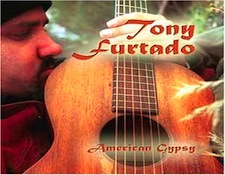It’s the time of year for saving money!

Peter Mulvey – Ten Thousand Mornings
Everybody loves to sing in the bathroom. Why? Because that
tile-encased reverberant space makes almost any voice sound really good. A
subway station is very much like a big bathroom, but with a dirtier floor.
Given its acoustic properties, it’s surprising that no one has thought to
record in a subway station. Peter Mulvey’s Ten
Thousand Mornings changes that. Recorded in the Boston underground subway
system, this CD defies the notion that you need an expensive recording studio
to make a decent-sounding CD.
Recorded entirely at the Davis Square T station on weekends,
none of the songs on Ten Thousand
Mornings is longer than 4 minutes, primarily because that was the largest
window of time between trains. Several of the songs are framed by the sounds of
arriving and departing engines. Made up solely of cover material, Mulvey’s
eclectic tastes span a range from Paul Simon, Leo Kotke, Bob Dylan, and Gillian
Welch to Elvis Costello, Randy Newman, David Hidalgo, Lennon and McCartney, Dar
Williams, and even Marvin Gaye. His performing style combines percussive
syncopated fingerstyle guitar with a commanding slightly gritty vocal style.
Jazzy inflections, funky rhythms and clever alternative guitar tunings make
Mulvey’s versions of even traditional songs like “Rain and Snow” sound unique.
Accompanied by a number of equally talented musicians including Jennifer
Kimbell, Erin McLeowan, Sean Staples, and Anita Suhanin on vocals, David
Goodrich on guitar, Mike Piehl on snare drum, and Chris Smither on shoes, Ten Thousand Mornings features rustic
but never Spartan musical arrangements.
Using a Roland VS-890 digital recorder Mulvey and mixing
engineer Dave Chalfant created a remarkably good sounding recording. Mulvey’s
voice is both natural and commanding without using the many studio effects that
most big-name pop stars and major heavy-weight producers seem to feel are
essential. Instead of gimmicks, Ten
Thousand Mornings uses talent and musicality to create powerful songs. Want
to hear what you can do with a bit of money and a lot of creativity? Give Ten Thousand Mornings a listen and find
out.

Is he a banjo player or a slide guitar player? Tony Furtado
likes to keep you guessing. His latest album, American Gypsy, features not only his vocals, but equal parts of
banjo (he’s a two-time National Banjo Champion) and bottleneck slide guitar.
His fifth solo album since 1989, This album covers a wide gamut of musical
styles from Blues to Celtic with even some rootsy rock and roll thrown in. The
opening cut “Oh Bertha Bertha” morphs a traditional old time tune into an
electric blues moan. The second tune “Angry Monk” features an elegant solo
acoustic guitar riff that is soon joined by banjo and slide guitar parts before
it veers off into jazz territory.
Joined by Myron Dove on bass, John Burr on keyboards, horn and
flautist Paul McCnadless, guitarist Gawain Mathews, and drummers Tom Brechtlein
and Aaron Johnson, Furtado leads his musical troops through radical remakes of
Mike Nesmith’s “Shelly’s Blues”, the traditional “Staggerlee,” and a number of
original tunes. Despite all the musical firepower at his disposal, Furtado
still remains grounded in melody and traditional acoustic textures.
My favorite song on American
Gypsy is “Hartford,” written in honor of the late John Hartford, whose
pioneering and eclectic work influenced many younger players, including Tony
Furtado. Lyrical, whimsical, and slightly wistful, “Hartford” rambles breezily
through changes that conjure up images of majestic riverboats steaming down
John Hartford’s beloved Mississippi river.
American Gypsy proves
how much room exists between the poles of traditional roots material and modern
jazz for poignant accessible intelligent music. Tony Furtado delivers the
goods.

Chip Taylor and Carrie Rodriguez – Let’s Leave This Town
Duos are tricky. Some voices just don’t work well together,
like Johnny and June Carter Cash. They always reminded me of a bullhorn and a
frog trying to sing together. Others voices meld so perfectly that from the
very first note they sound as if they were born to sing together. Chip Taylor
and Carrie Rodriguez have a synergy that makes beautiful music. Along with
their killer vocal harmonies, Chip Taylor writes great songs and Carrie is one
hot Texas-style fiddler. Add in John McGann on acoustic guitar and mandolin,
Jim Whitney on upright bass, Dave Mattacks on drums and percussion, and you’ve
got a recipe for a stellar CD.
Ten of the twelve songs on Let’s
Leave This Town are written by Chip Taylor. The second cut “Him Who Saved
Me” typifies Taylor’s style, combining religious imagery with topical rustic
and secular references. At his best, Chip Taylor’s work is in the same league
as two other great Texas songwriters Townes Van Zant and Guy Clark. Carrie
Rodriguez’ vocal style has equal parts Nancy Griffith, Emmylou Harris, and Dar
Williams, mixed into a Texas-style gumbo. Her fiddle work calls up Johnny
Gimble and Chubby Wise, with just the right hesitation and syncopation to
seriously swing.
If a space alien appeared and demanded to know under penalty of
immediate vaporization what Texas music was all about I’d give him a copy of Let’s Leave This Town confident that
after two songs he’d be reduced to a pulsating pile of contented jelly. Damn,
this album almost makes me wish I were a Texan.





